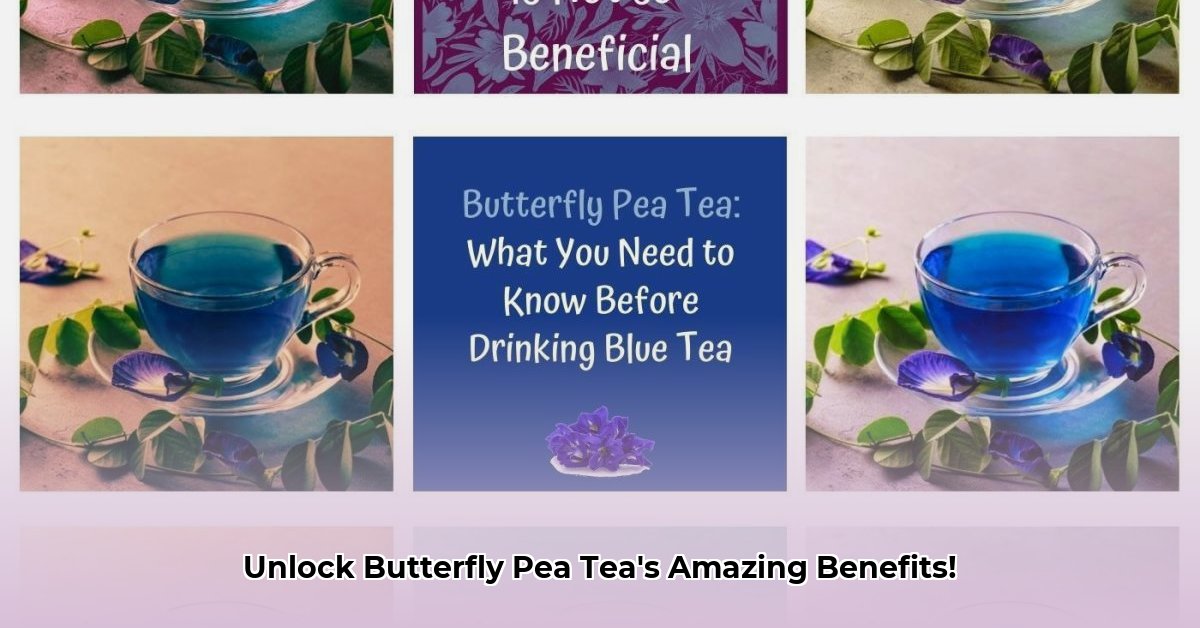
Butterfly pea flower tea, brewed from the vibrant blue Clitoria ternatea flower, is more than just a visually stunning beverage. Its captivating color-changing properties and potential health benefits are sparking increasing interest. While more research is needed to solidify many claims, let's explore what science currently suggests, along with a practical guide to brewing and using this unique tea.
The Allure of Butterfly Pea Flower Tea
This isn't your grandmother's chamomile. Butterfly pea flower tea boasts a striking deep blue hue, thanks to anthocyanins—powerful antioxidants also found in many colorful fruits and vegetables. The truly remarkable aspect? This blue transforms into a vibrant purple when an acid, like lemon juice, is added. This pH-sensitive color change makes it a natural food coloring agent and a visually captivating drink. But the beauty is only part of the story.
Potential Health Benefits: A Cautious Approach
While anecdotal evidence and some preliminary studies suggest several potential health benefits, it's crucial to approach these claims with a balanced perspective. More robust, large-scale research is needed to confirm these effects definitively.
Antioxidant Powerhouse? Possibly.
The high concentration of anthocyanins in butterfly pea flower tea suggests significant antioxidant potential. Antioxidants combat free radicals, unstable molecules linked to aging and various diseases. This suggests a role in supporting overall health, but further research is needed to specify the extent of these protective effects. Other beneficial compounds, including ternatins and kaempferol, further strengthen its antioxidant profile.
Brain Boost? More Research Needed.
Some early studies hint at potential cognitive benefits, suggesting butterfly pea flower tea might improve memory and concentration. However, these are preliminary findings, and more extensive research is necessary to confirm these effects and understand the optimal dosage. Don’t rely on this alone for cognitive enhancement.
Skin and Hair Benefits? Anecdotal Evidence Only.
Many people report positive effects on skin and hair, attributing improved complexion and hair shine to the tea's antioxidant properties. This is primarily anecdotal, however; scientific evidence supporting these claims is lacking.
Brewing the Perfect Cup: A Step-by-Step Guide
Brewing butterfly pea flower tea is simple and straightforward.
- Gather Your Supplies: You will need dried butterfly pea flowers (easily found online or in health food stores) and hot water (around 175-185°F, not boiling).
- Steep the Flowers: Add 1-2 teaspoons of dried flowers to a cup of hot water.
- Infuse the Color: Allow the mixture to steep for 5-7 minutes, or longer for a stronger flavor and color.
- Strain and Enjoy: Strain the tea through a fine-mesh sieve to remove the flower pieces. Enjoy hot or chilled.
Beyond the Cup: Culinary Creativity
The fun doesn't end with a simple cup of tea! Butterfly pea flower's color-changing capability makes it an exciting ingredient in cooking and cocktails. Add a splash of lemon to blue lemonade to create a beautiful purple hue, or use it to color cakes and other desserts. The possibilities are vast!
Important Considerations
Although generally considered safe, some individuals might experience allergic reactions. It's always wise to start with a small amount to gauge your tolerance. Pregnant or breastfeeding individuals should consult their doctor before consuming butterfly pea tea.
Interaction with Medications: Consult Your Doctor
This is crucial. While preliminary research has not revealed significant drug interactions, it's vital to consult your doctor, especially if you're taking medications affecting blood clotting, blood pressure, or other health conditions. They can assess any potential risks and provide guidance specific to your circumstances. Never self-treat or disregard medical advice.
The Bottom Line: A Beautiful and Potentially Beneficial Brew
Butterfly pea flower tea offers a unique combination of visual appeal and potential health benefits. While more research is needed to confirm many claims, its antioxidant properties and intriguing color-changing abilities make it a fascinating beverage worth exploring. Always prioritize safety and consult your healthcare provider before making significant dietary changes or using herbal remedies.